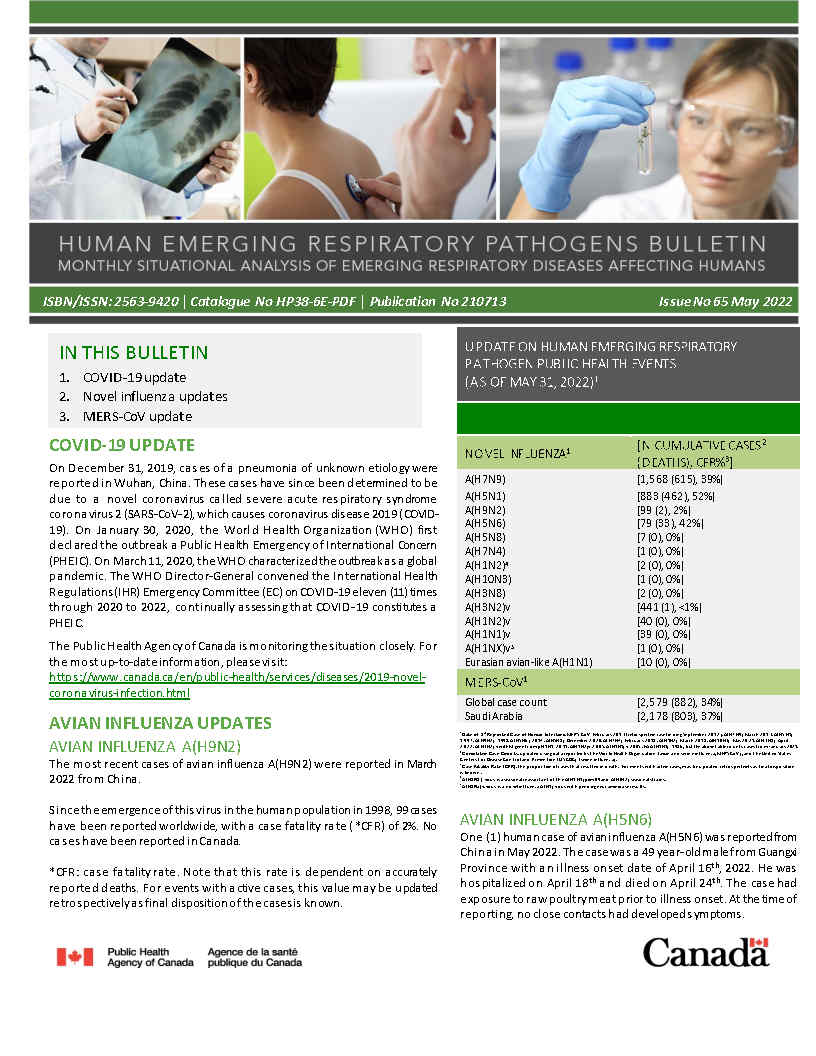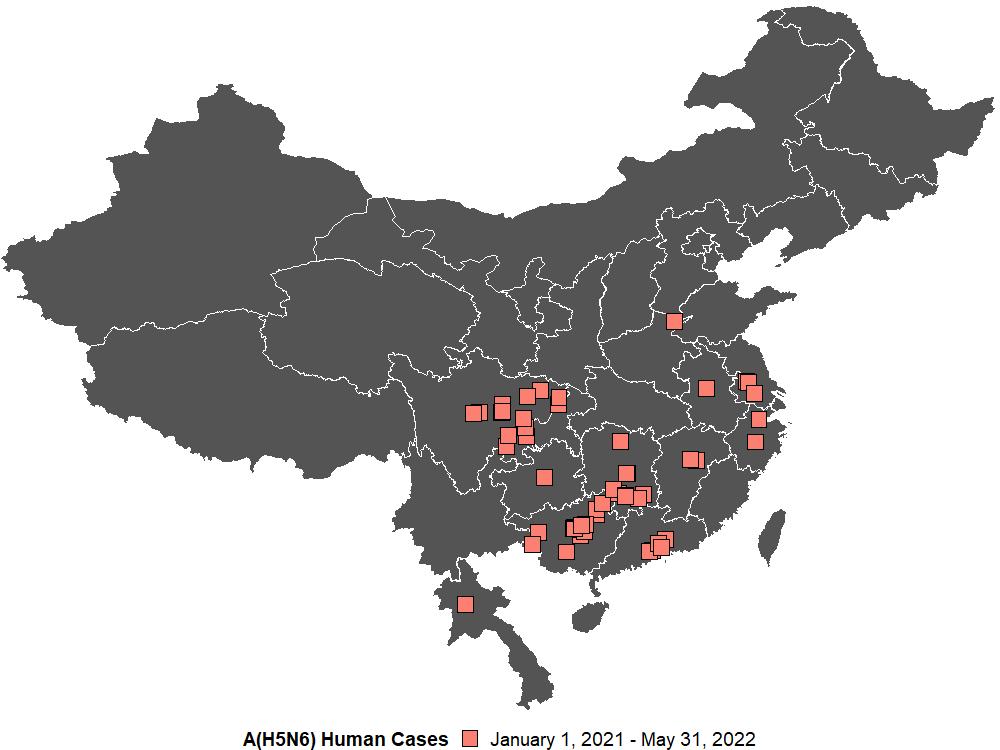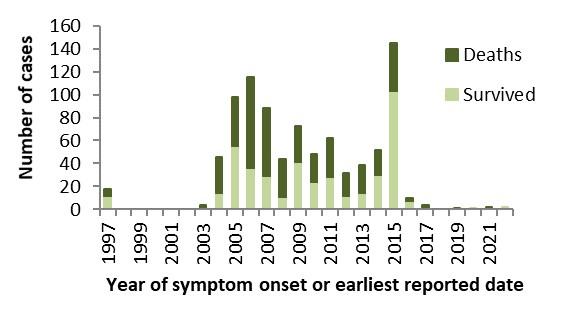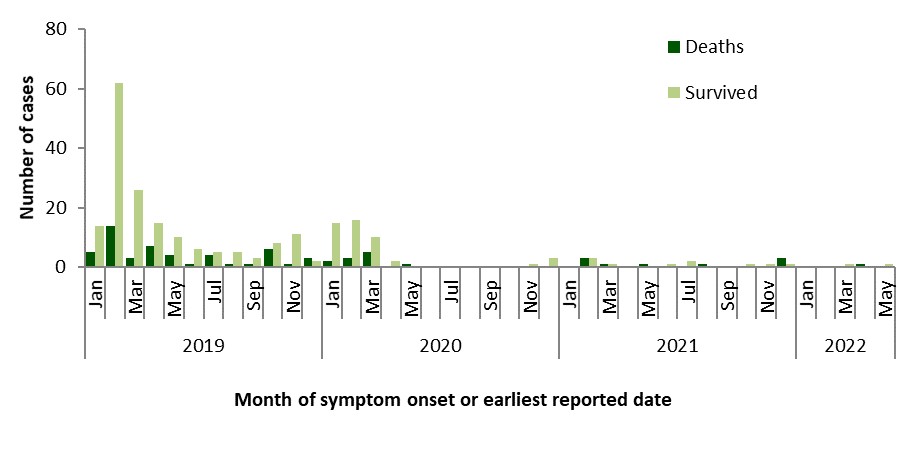Human emerging respiratory pathogens bulletin: Issue 65, May 2022

Download the alternative format
(PDF format, 1.27 MB, 3 pages)
Organization: Public Health Agency of Canada
Published: 2022-06-14
Monthly situational analysis of emerging respiratory diseases affecting humans (data to May 31, 2022).
In this bulletin
- COVID-2019 update
- Avian influenza updates
- Swine influenza updates
- Middle East respiratory syndrome coronavirus (MERS-CoV) update
| Novel influenzaFootnote 1 | Cumulative Case CountFootnote 2 | Deaths | Case Fatality Rate %Footnote 3 |
|---|---|---|---|
| A(H7N9) | 1,568 | 615 | 39% |
| A(H5N1) | 883 | 462 | 52% |
| A(H9N2) | 99 | 2 | 2% |
| A(H5N6) | 79 | 33 | 42% |
| A(H5N8) | 7 | 0 | 0% |
| A(H7N4) | 1 | 0 | 0% |
| A(H1N2)Footnote 4 | 2 | 0 | 0% |
| A(H10N3) | 1 | 0 | 0% |
| A(H3N8) | 2 | 0 | 0% |
| A(H3N2)v | 441 | 1 | <1% |
| A(H1N2)v | 40 | 0 | 0% |
| A(H1N1)v | 39 | 0 | 0% |
| A(H1NX)vFootnote 5 | 1 | 0 | 0 |
| Eurasian avian-like A(H1N1) | 10 | 0 | 0% |
| MERS-CoVFootnote 1 | Cumulative Case CountFootnote 2 | Deaths | Case Fatality Rate %Footnote 3 |
| Global Case Count | 2,579 | 882 | 34% |
| Saudi Arabia | 2,178 | 803 | 37% |
|
|||
COVID-19 update
On December 31, 2019, cases of a pneumonia of unknown etiology were reported in Wuhan, China. These cases have since been determined to be due to a novel coronavirus called severe acute respiratory syndrome coronavirus 2 (SARS-CoV-2), which causes coronavirus disease 2019 (COVID-19). On January 30, 2020, the World Health Organization (WHO) first declared the outbreak a Public Health Emergency of International Concern (PHEIC). On March 11, 2020, the WHO characterized the outbreak as a global pandemic. The WHO Director-General convened the International Health Regulations (IHR) Emergency Committee (EC) on COVID-19 eleven (11) times through 2020 to 2022, continually assessing that COVID-19 constitutes a PHEIC.
The Public Health Agency of Canada is monitoring the situation closely.
Avian influenza updates
Avian influenza A(H9N2)
The most recent cases of avian influenza A(H9N2) were reported in March 2022 from China.
Since the emergence of this virus in the human population in 1998, 99 cases have been reported worldwide, with a case fatality rate (*CFR) of 2%. No cases have been reported in Canada.
*CFR: case fatality rate. Note that this rate is dependent on accurately reported deaths. For events with active cases, this value may be updated retrospectively as final disposition of the cases is known.
Avian influenza A(H5N6)
One (1) human case of avian influenza A(H5N6) was reported from China in May 2022. The case was a 49 year-old male from Guangxi Province with an illness onset date of April 16th, 2022. He was hospitalized on April 18th and died on April 24th. The case had exposure to raw poultry meat prior to illness onset. At the time of reporting, no close contacts had developed symptoms.
A total of 79 laboratory-confirmed human cases of avian influenza A(H5N6), including at least 33 deaths (CFR: 42%) have been reported globally since 2014. Since January 2021, 53 cases of avian influenza A(H5N6) have been reported globally (Figure 2); 52 A(H5N6) cases were reported from China and one (1) case was reported from Lao PDR (Figure 3). So far, 21 A(H5N6) cases have been reported worldwide in 2022. No cases have been reported in Canadian residents.
Avian influenza A(H3N8)
In May 2022, one (1) new case of A(H3N8) was reported from China. The case, a 5 year-old male living in Hunan Province, had an illness onset date of May 9th. The case had visited a wet market with poultry stalls. He experienced mild symptoms and was not admitted to the hospital. The case has since recovered. At the time of reporting, none of the case's close contacts have tested positive for A(H3N8). Environmental testing of the wet market confirmed samples that were positive for influenza A, including H5 and H9, but no samples tested positive for H3. Samples from the supermarket and the case's residence all tested negative for influenza A.
This is the second human case of A(H3N8) ever reported worldwide. The first human case of A(H3N8) was reported from Henan Province, China in April 2022. The CFR for A(H3N8) is 0%; however, with only two human cases to date, the full spectrum of disease is highly uncertain.
Full viral sequences isolated from the two cases were deposited to the Global Initiative for Sharing Avian Influenza Data (GISAID). For the case of A(H3N8) reported from Hunan Province, current nomenclature designates this isolate A/Changsha/1000/2022 (H3N8). For the case reported from Henan Province in April 2022, current nomenclature designates this isolate A/Henan/4-14CNIC/2022 (H3N8). These two cases are not epidemiologically linked.
Avian influenza A(H5N1)
The most recent case of avian influenza A(H5N1) was reported in April 2022 from the United States.
There have been 883 human cases of A(H5N1) reported globally since 1997, with a CFR of 52% (Figure 4). No domestically acquired A(H5N1) infections have ever been reported in Canada. Two (2) A(H5N1) cases have been reported worldwide in 2022. In 2014, Canada (Alberta) reported one single fatal case of A(H5N1) in a resident returning from travel in China.
Swine influenza updates
Swine origin influenza A(H1N2)v
The most recent case of swine origin influenza A(H1N2)v was reported in February 2022 from the US.
A total of 40 A(H1N2)v cases have been reported globally since 2005, with a 0% case fatality rate. One (1) A(H1N2)v case has been reported worldwide in 2022. Three (3) A(H1N2)v detections have been reported in Canadian residents since reporting began in 2005, and the latest case in Canada was reported in November 2021 from Manitoba.
Swine origin influenza A(H3N2)v
The most recent case of swine origin influenza A(H3N2)v was reported in October 2021 from the US.
Globally, 441 A(H3N2)v cases have been reported since 2005, with <1% case fatality rate. No A(H3N2)v cases have been reported worldwide in 2022. Two (2) A(H3N2)v detections have been reported in Canadian residents since reporting began in 2005, with the latest case reported in June 2021.
Swine origin influenza A(H1N1)v
In May 2022, one (1) new case of A(H1N1)v was reported from North Rhine-Westphalia, Germany. The case was a 34 year-old patient who reported influenza-like symptoms. The case was not hospitalized and has since recovered. The case had no direct contact with pigs; however, they lived in a region with many swine farms and had contact with swine farmers.
Globally, 39 human cases of A(H1N1)v have been reported since 2005, with no associated fatalities. Two (2) A(H1N1)v cases have been reported worldwide in 2022. Two (2) A(H1N1)v detections have been reported in Canadian residents since reporting began in 2005, with the latest case reported in April 2021.

Note: Map was prepared by the Centre for Immunization and Respiratory Infectious Diseases (CIRID) using data from the latest WHO Event Information Site (EIS) postings and Weekly US Influenza Surveillance Reports (FluView). This map reflects data available through these publications as of May 31, 2022.
Figure 1 - Text description
- One A(H5N6) case was reported in China.
- One A(H3N8) case was reported in China.
- One A(H1N1)v case was reported in Germany.

Note: Graph was prepared by the Centre for Immunization and Respiratory Infectious Diseases (CIRID) using data from the WHO EIS postings and the Hong Kong Centre for Health Protection (CHP) press releases. This graph reflects data available as of May 31, 2022.
Figure 2 - Text description
| Month | Cases | |
|---|---|---|
| 2021 | Jan | 1 |
| Feb | 2 | |
| Mar | 2 | |
| Apr | 0 | |
| May | 0 | |
| June | 1 | |
| July | 4 | |
| Aug | 6 | |
| Sep | 6 | |
| Oct | 4 | |
| Nov | 0 | |
| Dec | 6 | |
| 2022 | Jan | 8 |
| Feb | 6 | |
| Mar | 3 | |
| Apr | 3 | |
| May | 1 |

Note: Map was prepared by the Centre for Immunization and Respiratory Infectious Diseases (CIRID) using data from the WHO EIS postings and the Hong Kong Centre for Health Protection (CHP) press releases. This map reflects data available through these publications as of May 31, 2022.
Figure 3 - Text description
- One case was reported out of Yongchuan, Chongqing Municipality.
- One case was reported out of Guizhou Province.
- One case was reported out of Anhui Province.
- Two cases were reported out of Guangxi Zhuang Autonomous Region.
- Two cases were reported out of Chengdu, Sichuan Province.
- One case was reported out of Bazhong, Sichuan Province.
- One case was reported out of Kaijiang, Sichuan Province.
- Two cases were reported out of Tongnan, Chongqing Municipality.
- One case was reported out of Xuanhan, Sichuan Province.
- Three cases were reported out of Guilin, Guangxi Zhuang Autonomous Region.
- One case was reported out of Yibin, Sichuan Province.
- Two cases were reported out of Huizhou, Guangdong Province.
- Two cases were repored out of Dongguan, Guangdong Province.
- One case was reported out of Laibin, Guangxi Zhuang Autonomous Region.
- Two cases were reported out of Chenzhou, Hunan Province.
- Four cases were reported out of Yongzhou, Hunan Province.
- One case was reported out of Changde, Hunan Province.
- One case was reported out of Zigong, Sichuan Province.
- One case was reported out of Nanning, Guangxi Zhuang Autonomous Region.
- Two cases were reported out of Hengyang, Hunan Province.
- One case was reported out of Baise, Guangxi Zhuang Autonomous Region.
- Two cases were reported out of Zhenjiang, Jiangsu Province.
- One case was reported out of Fuzhou, Fujian Province.
- One case was reported out of Yangzhou, Jiangsu Province.
- One case was reported out of Hechi, Guangxi Zhuang Autonomous Region.
- Two cases were reported out of Liuzhou, Guangxi Zhuang Autonomous Region.
- One case was reported out of Jiangxi Province.
- One case was reported out of Puyang, Henan Province.
- One case was reported out of Deyang, Sichuan Province.
- One case was reported out of Baise, Guangxi Zhuang Autonomous Region

Note: Graph was prepared by the Centre for Immunization and Respiratory Infectious Diseases (CIRID) using data from the WHO EIS postings, the US CDC HAN, and WHO cumulative case counts. This graph reflects data available as of May 31, 2022.
Figure 4 - Text description
| Number of Cases | Deaths | Survived | |
|---|---|---|---|
| 1997 | 18 | 6 | 12 |
| 1998 | 0 | 0 | 0 |
| 1999 | 0 | 0 | 0 |
| 2000 | 0 | 0 | 0 |
| 2001 | 0 | 0 | 0 |
| 2002 | 0 | 0 | 0 |
| 2003 | 4 | 4 | 0 |
| 2004 | 46 | 32 | 14 |
| 2005 | 98 | 43 | 55 |
| 2006 | 115 | 79 | 36 |
| 2007 | 88 | 59 | 29 |
| 2008 | 44 | 33 | 11 |
| 2009 | 73 | 32 | 41 |
| 2010 | 48 | 24 | 24 |
| 2011 | 62 | 34 | 28 |
| 2012 | 32 | 20 | 12 |
| 2013 | 39 | 25 | 14 |
| 2014 | 52 | 22 | 30 |
| 2015 | 145 | 42 | 103 |
| 2016 | 10 | 3 | 7 |
| 2017 | 4 | 2 | 2 |
| 2018 | 0 | 0 | 0 |
| 2019 | 1 | 1 | 0 |
| 2020 | 1 | 0 | 1 |
| 2021 | 2 | 1 | 1 |
| 2022 | 2 | 0 | 2 |
Middle East respiratory syndrome coronavirus (MERS-CoV) update
In May 2022, one (1) new MERS-CoV case was reported from Oman. The case, a 34 year-old male, was exposed to camels, sheep and goats prior to illness onset. He was admitted the hospital for treatment. As of the time of reporting, he remains in critical condition. No additional details about the case or the status of close contacts have been released.
A total of 2,579 laboratory-confirmed cases of MERS-CoV, including 882 deaths, have been reported globally since 2012 by the WHO (CFR: 34%). Three (3) MERS-CoV cases have been reported worldwide in 2022. No cases have been reported in Canada.

Note: Graph was prepared by the Centre for Immunization and Respiratory Infectious Diseases (CIRID) using data from the WHO Disease Outbreak News and Saudi Arabia's Ministry of Health. This graph reflects data available as of May 31, 2022.
Figure 5 - Text description
| Deaths | Survived | ||
|---|---|---|---|
| 2019 | Jan | 5 | 14 |
| Feb | 14 | 62 | |
| Mar | 3 | 26 | |
| Apr | 7 | 15 | |
| May | 4 | 10 | |
| June | 1 | 6 | |
| July | 4 | 5 | |
| Aug | 1 | 5 | |
| Sep | 1 | 3 | |
| Oct | 6 | 8 | |
| Nov | 1 | 11 | |
| Dec | 3 | 2 | |
| 2020 | Jan | 2 | 15 |
| Feb | 3 | 16 | |
| Mar | 5 | 10 | |
| Apr | 0 | 2 | |
| May | 1 | 0 | |
| June | 0 | 0 | |
| July | 0 | 0 | |
| Aug | 0 | 0 | |
| Sep | 0 | 0 | |
| Oct | 0 | 0 | |
| Nov | 0 | 1 | |
| Dec | 0 | 3 | |
| 2021 | Jan | 0 | 0 |
| Feb | 3 | 3 | |
| Mar | 1 | 1 | |
| Apr | 0 | 0 | |
| May | 1 | 0 | |
| June | 0 | 1 | |
| July | 0 | 2 | |
| Aug | 1 | 0 | |
| Sep | 0 | 0 | |
| Oct | 0 | 1 | |
| Nov | 0 | 1 | |
| Dec | 3 | 1 | |
| 2022 | Jan | 0 | 0 |
| Feb | 0 | 0 | |
| Mar | 0 | 1 | |
| Apr | 1 | 0 | |
| May | 0 | 1 |